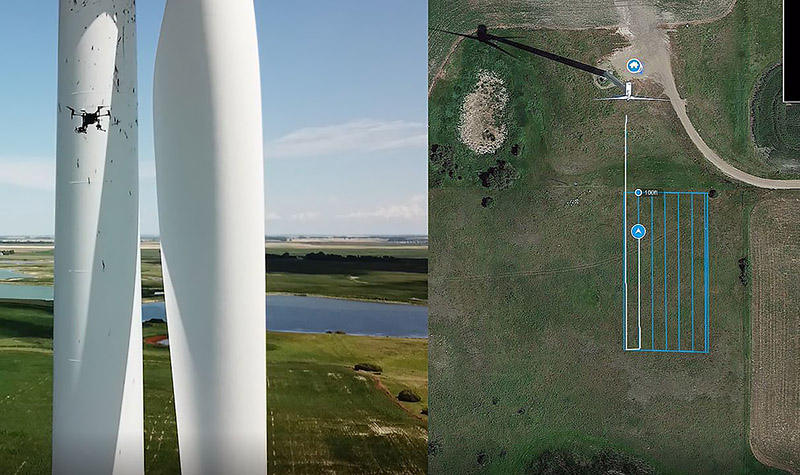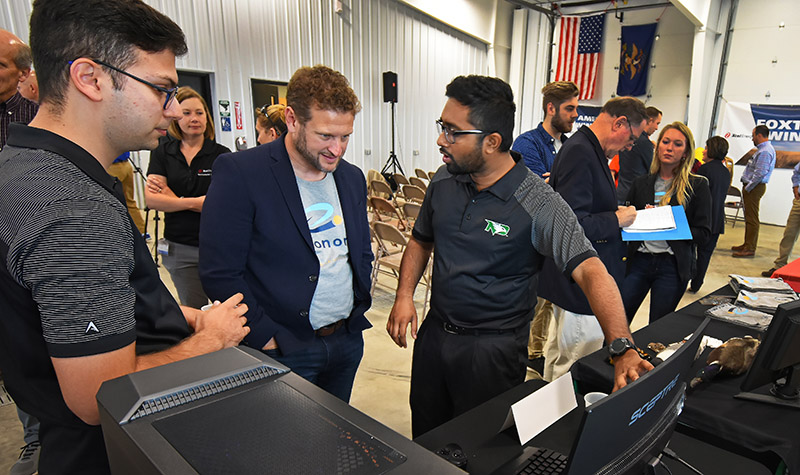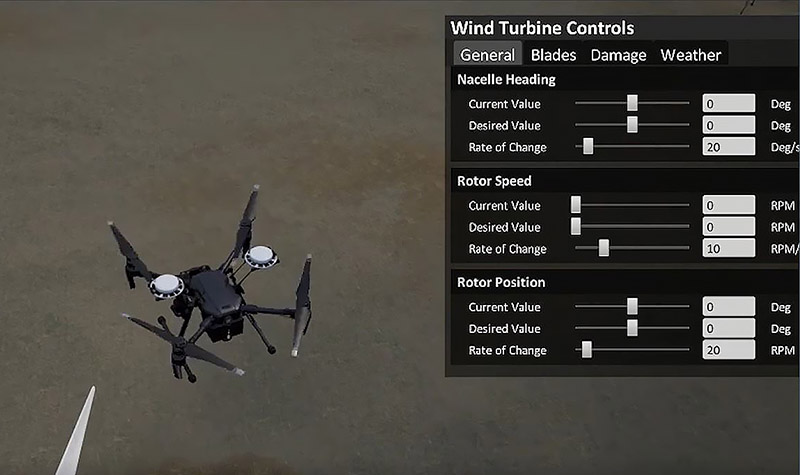13 Sep Airtonomy partners with UND Aerospace Foundation, Xcel Energy and Microsoft

Airtonomy will test its idea of autonomous drone flight for commercial operations by inspecting wind turbines at Xcel Energy’s Foxtail Wind Farm near Kulm, N.D. On the left, a drone conducts a wind turbine inspection. On the right is a map of the drone’s programmed autonomous flight path. Photo courtesy Airtonomy.
Josh Riedy, CEO of Airtonomy, foresees a day when there won’t be one pilot flying one drone on one day to accomplish one mission. Instead, it will be one pilot flying multiple drones to accomplish thousands of missions over the course of a year.
Thanks to a $100,000 grant from the Microsoft TechSpark program and investments from the UND Aerospace Foundation and other organizations, Riedy’s vision will soon be happening at an Xcel Energy Inc. wind energy project in North Dakota.
“I truly believe North Dakota is the only place in the U.S. that can pull this off right now,” said Riedy, founder of a Grand Forks, N.D., startup company specializing in the autonomous operation of unmanned aircraft systems (UAS). “What makes us special in North Dakota is that you can get all of these players to come together.”
Those other players include the UND Research Institute for Autonomous Systems (RIAS), the Northern Plains UAS Test Site, the North Dakota Department of Commerce, the North Dakota Renewable Energy Council, the Grand Forks Region Economic Development Corp. and the city of Grand Forks. In all, Airtonomy has attracted about $1.5 million in investments to develop and demonstrate its technology.
To keep costs down, Airtonomy plans to use commercially available drones, modified to gather data and images transmitted wirelessly to cloud storage. This UAS technology will be demonstrated at Xcel’s new $200 million Foxtail Wind Farm near Kulm, N.D. There, drones located in secure housing units will be programmed to perform wind turbine inspection, wildlife assessment and perimeter check missions autonomously, using artificial intelligence (AI) and machine learning to become more proficient at the tasks every time they fly.
Good fit for UND Aerospace
Chuck Pineo, CEO of the UND Aerospace Foundation, said there are several factors that led the group to invest in Airtonomy
“Opportunities in UAS are a good fit for moving the John D. Odegard School of Aerospace Sciences forward,” he said. “It looked like a good entrepreneurial opportunity because of the use of AI with unmanned technology. We can be of help with higher risk projects. We also like that it’s using UND people and UND technologies. It provides opportunities within the UAS test site and with RIAS and other entities.”

During an event last month at Xcel’s Foxtail Wind Farm, Airtonomy CEO Josh Riedy (center) visits with Ph.D. students Shudipto Sekhar Roy (right) and Ramtin Kardan with the UND Research Institute for Autonomous Systems (RIAS). Photo by Patrick C. Miller/UND Today.
TechSpark — launched two years ago from Microsoft’s Fargo campus — is a civic program within the company’s philanthropies focused on driving economic development and job creation. Originally intended for rural America, it now operates in eight areas across the U.S.
“When we heard about Airtonomy and what Josh was doing, it really was kind of a perfect fit, especially when we knew that he was partnering with UND Aerospace,” said Taya Spelhaug, TechSpark’s North Dakota manager. “We really wanted to do this because of the breakthrough in UAS autonomous operations and the benefits this project will have to agriculture, energy and public safety. Supporting local startups is also something we like to do.”
A platform for drone apps
Much as a smartphone uses an underlying operating system to run many different applications, Airtonomy’s solution provides the ability to run apps performing a variety of missions, ranging from wind turbine inspections to wildlife surveys to detecting leaks in pipelines at other energy infrastructure facilities.
“Our focal point is making autonomous drone operations a platform in which you can merge the drones with the various tasks you want it to do,” Riedy said. “Airtonomy is the layer in between. We want to be the glue that no one sees but enables all of it to happen. Our goal is to have a UAS platform that companies own and use as a tool around the clock 365 days a year for different purposes. That’s value added.”

Airtonomy’s operating system enables unmanned aircraft to perform a wide variety of functions, much as a smartphone uses apps for different tasks. Photo courtesy Airtonomy.
As an example of the system’s flexibility, Airtonomy is working with Susan Felege, UND associate professor of biology, to use drones at the Foxtail Wind Farm to conduct wildlife surveys on migratory birds and endangered raptors, such as golden and bald eagles. This, she explained, will assist Xcel in remaining compliant with federal regulations.
“It’s a natural progression of applying automation to the wildlife surveys I’ve been doing,” Felege said. “We can look at bird mortality rates and help the company take steps to minimize those mortalities. You can figure out which birds are getting hit and then develop scenarios to do things like shutting off turbines to minimize strikes.”
Proving it’s safe
Adding autonomy, AI and machine learning to commercial UAS operations creates other issues that must be addressed.
“There are many challenges with unmanned aircraft, and this project attacks one of them: getting more autonomy in the operation and having one pilot operate more than one aircraft,” said Mark Askelson, RIAS director. “I would call it a Grand Challenge type of problem, not just for the FAA (Federal Aviation Administration), but also within the Department of Transportation and Department of Defense. They’re also researching the validation of autonomy and ways to mitigate the risks of AI to a level that’s acceptable.”

Shown at Xcel Energy’s Foxtail Wind Farm from the left are: Shudipto Sekhar Roy, RIAS; Ramtin Kardan, RIAS; Jeremiah Neubert, UND mechanical engineering; Susan Felege, UND biology; Mark Askelson, RIAS; Josh Riedy, Airtonomy; Frank Christophersen, Terma; Jennifer Eckman, Northern Plains UAS Test Site; Jeff Schleicher, Terma; and Nick Flom, Northern Plains UAS Test Site. Photo courtesy of Airtonomy.
As Askelson explained, using AI to help a drone make decisions means that the aircraft might not do the same thing every time it’s faced with a particular scenario. Therefore, traditional means of testing for potential problems aren’t necessarily useful. To help convince the FAA that the risks can be mitigated, simulations are used to demonstrate safe operations, and safeguards are built into the system to override potential problems.
“We have to be able to design the autonomy and mitigation to the point where we can prove that we can do these things safely,” Askelson said. “That’s a big part of what we’re doing here — demonstrating and showing that this is safe. This is how we make sure that we’re at the right level of safety.”
Leveraging wind farm radar
Riedy said it’s why having Microsoft and Xcel’s involvement is a critical part of developing Airtonomy’s technology. One of the unique aspects of the Foxtail Wind Farm is that it will employ a radar system developed by Terma—an aerospace company based in Arlington, Va.— to detect the presence of nearby manned aircraft. The red warning lights on the wind turbines will turn on only when aircraft are near, thus preserving the night sky for local residents. But the radar can also be used to determine when it’s safe to fly UAS.
“We’re going to leverage that technology and allow Airtonomy to fly within the wind farm’s footprint with the approval of the FAA,” said Mark Nisbet, North Dakota principal manager with Xcel. “We’re extremely excited about it.”
In addition, Microsoft has opened its doors to Riedy and Airtonomy, enabling the company to incorporate its Azure cloud computing platform, AI software and AirSim (Aerial Informatics and Robotics Simulation) into development and testing.
“It’s kind of a bonus,” said Spelhaug. “Knowing that Microsoft is in the region, it was a natural fit for Josh to also work with us. It’s pretty cool to see that in action.
“Our investment is Microsoft saying we know that this is a viable product; we stand behind it,” she continued. “It’s really allowed Josh to move forward and have a multiplier effect by attracting more investments.”


